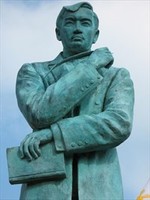Dr. José Rizal Monument
Introduction
Text-to-speech Audio
Images
Dr. José Rizal Monument in Chicago's Lincoln Park

A closer look at the bronze statue

Dr. José Rizal (1861-1896)

Backstory and Context
Text-to-speech Audio
José Protasio Rizal Mercado y Alonso Realonda was born to a wealthy family on June 19, 1861 in the town of Calamba in the Philippines, which at the time was under the control of Spain. The son of a prosperous Filipino landowner, he attended a private high school before enrolling at the University of St. Thomas in Manila. An excellent student, Rizal traveled to Europe in 1882. In the course of the subsequent decade, he studied medicine at the University of Madrid and the University of Heidelberg in Germany.
While living and studying in Europe, Rizal wrote his first novel. Published in 1887, Noli Me Tángere (Latin: “touch me not”) laid bare the cruelty of Spanish colonial rule in the Philippines. Four years later, he published a sequel, El Filibusterismo (1891). Together, the two works of fiction firmly established Rizal as one of the leading voices of the Philippine Propaganda Movement. Rather than advocating for Philippine independence from Spain, he and others in the movement called for the adoption of various reform measures, including Philippine representation in the Cortes Generales (the Spanish parliament), freedom of assembly and expression, and equality before the law for Spaniards and Filipinos.
In 1892, after living in Europe for a decade, Rizal returned to his native land. Upon his arrival in the Philippines, he founded the Liga Filipina, a secret nonviolent organization associated with the Propaganda Movement. Spanish colonial authorities quickly became aware of its existence and arrested Rizal. They then exiled him to Dapitan on the island of Mindanao. While living there, Rizal practiced medicine, taught classes, and collected and recorded samples of local flora and fauna.
Four years after Rizal returned to the Philippines from Europe, the Katipunan, a secret Filipino nationalist society, began an armed revolt against Spanish rule. Despite the fact that Rizal was neither associated with the group nor the armed uprising, Spanish colonial authorities arrested him. After trying and convicting Rizal of sedition, the Spanish military publicly executed him by firing squad in Manila on December 30, 1896. He was thirty-five years old. Rizal’s death convinced many Filipinos that Spain would never seriously entertain calls for reform and that independence was the best and only option going forward. Today, the date of his death is marked by parades and celebrations in the Philippines and among Filipinos living all over the world.
In preparation for the one hundredth anniversary of Philippine independence, Chicago chapters of the Order of the Knights of Rizal and Ladies of Rizal began a fundraising campaign in 1994 to erect a monument in honor of Rizal in the city’s Lincoln Park. Thanks to donations from many within Chicago’s Filipino community, the committee raised enough money to recast an existing statue of Rizal located at the Rizal Shrine in Dapitan. Sculptor Antonio “Lito” Mandejar, who designed the original monument in Dapitan, also completed the bronze replica. Dedicated on June 19, 1999, what would have been Rizal’s 138th birthday, the monument consists of a statue of the Philippine national hero on a Black granite pedestal. The bronze sculpture depicts Rizal standing upright with his arms crossed. With a book in his left hand and a quill pen in his right, he gazes out into the distance.
Sources
"Dr. José P. Rizal." Center for Philippine Studies. University of Hawaii Manoa. Web. 24 February 2021 <http://www.hawaii.edu/cps/rizal.html>.
"Dr. José Rizal Monument." Chicago Park District. City of Chicago. Web. 24 February 2021 <https://www.chicagoparkdistrict.com/parks-facilities/dr-jose-rizal-monument>.
"José Rizal." Encyclopædia Britannica. 7 January 2021. Web. 24 February 2021 <https://www.britannica.com/biography/Jose-Rizal>.
"José Rizal." The World of 1898: The Spanish-American War. Hispanic Division. Library of Congress. 24 February 2021 <https://www.loc.gov/rr/hispanic/1898/rizal.html>.
"Lincoln Park: Dr. José Rizal Monument." Chicago Park District. City of Chicago. 27 July 2015. Web. 24 February 2021 <https://www.chicagoparkdistrict.com/media/lincoln-park-dr-jose-rizal-monument>.
https://www.chicagoparkdistrict.com/parks-facilities/dr-jose-rizal-monument
https://www.waymarking.com/waymarks/WMQYVP_Dr_Jose_Rizal_Monument_Chicago_IL
https://en.wikipedia.org/wiki/José_Rizal
